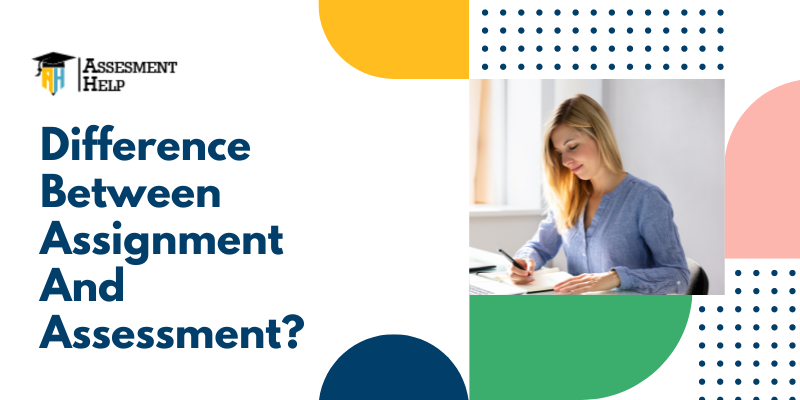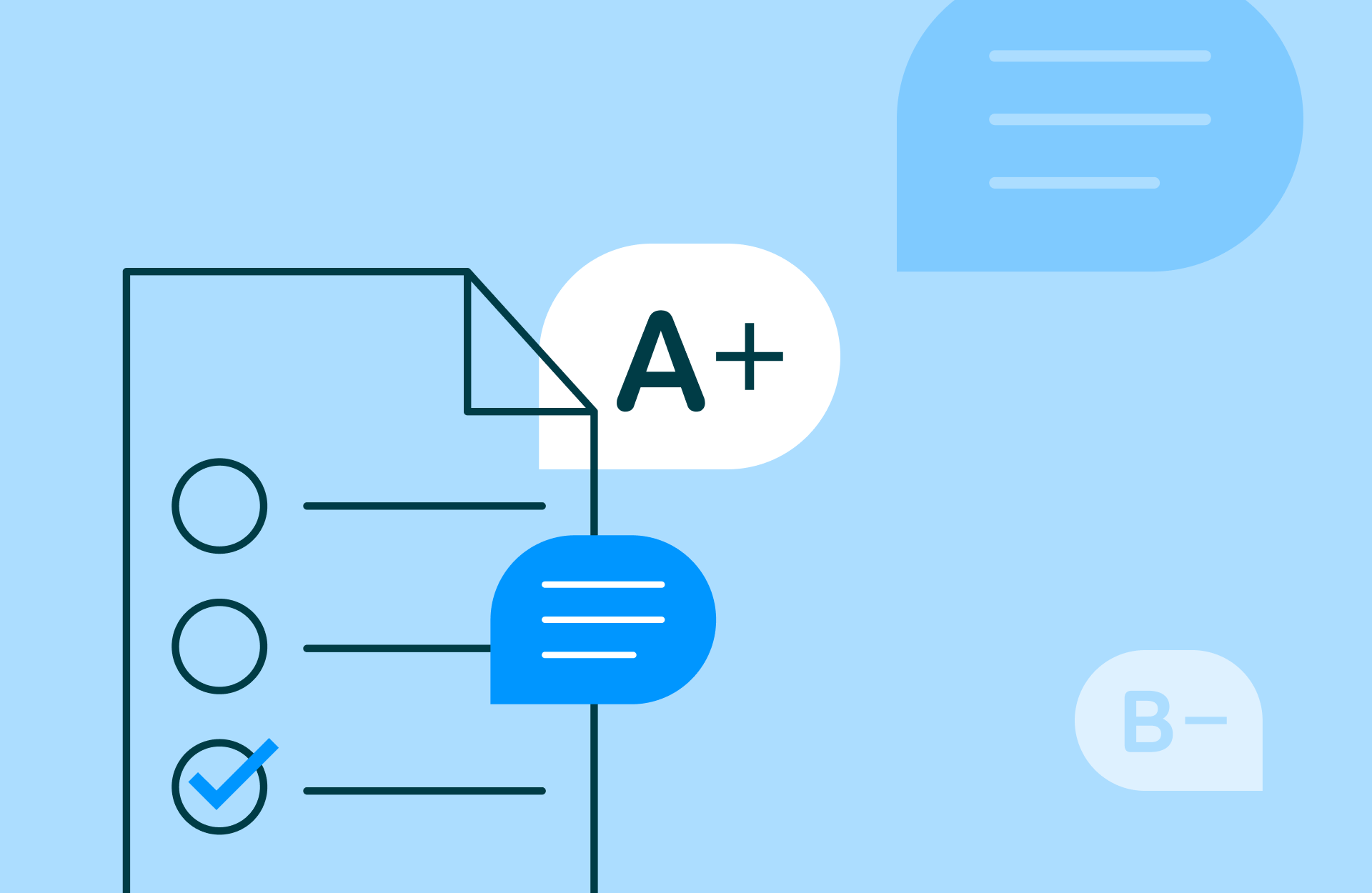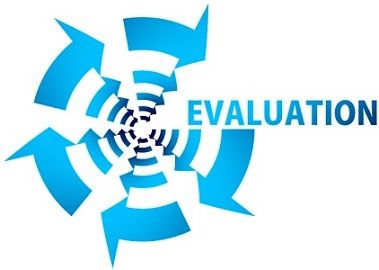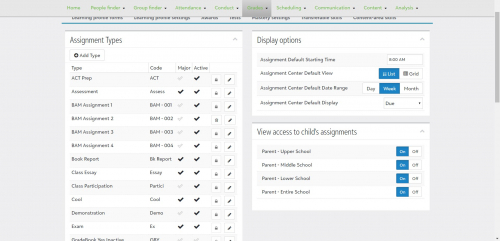
Home » Education » What is the Difference Between Assignment and Assessment

What is the Difference Between Assignment and Assessment
The main difference between assignment and assessment is that assignments refer to the allocation of a task or set of tasks that are marked and graded while a ssessment refers to methods for establishing if students have achieved a learning outcome, or are on their way toward a learning objective.
Assignments and assessment are two important concepts in modern education. Although these two words are similar, they have different meanings. Assignments are the pieces of coursework or homework students are expected to complete. Assessment, on the other hand, refer to the method of assessing the progress of students. Sometimes, assignments can act as tools of assessment.
Key Areas Covered
1. What is an Assignment – Definition, Goals, Characteristics 2. What is an Assessment – Definition, Characteristics 3. Difference Between Assignment and Assessment – Comparison of Key Differences

What is an Assignment
Assignments are the pieces of coursework or homework given to the students by teachers at school or professors at university. In other words, assignments refer to the allocation of a task or set of tasks that are marked and graded. Assignments are essential components in primary, secondary and tertiary education.
Assignments have several goals, as described below:
– gives students a better understanding of the topic being studied
– develops learning and understanding skills of students
– helps students in self-study
– develops research and analytical skills
– teaches students time management and organization
– clear students’ problems or ambiguities regarding any subject
– enhance the creativity of students

Generally, educators assign such tasks to complete at home and submit to school after a certain period of time. The time period assigned may depend on the nature of the task. Essays, posters, presentation, annotated bibliography, review of a book, summary, charts and graphs are some examples of assignments. Writing assignments develop the writing skills of students while creative assignments like creating posters, graphs and charts and making presentation enhance the creativity of students. Ultimately, assignments help to assess the knowledge and skills, as well as the students’ understanding of the topic.
What is an Assessment
Assessment refers to methods for establishing if students have achieved a learning outcome, or are on their way toward a learning objective. In other words, it is the method of assessing the progress of students. Assessment helps the educators to determine what students are learning and how well they are learning it, especially in relation to the expected learning outcomes of a lesson. Therefore, it helps the educator to understand how the students understand the lesson, and to determine what changes need to be made to the teaching process. Moreover, assessment focuses on both learning as well as teaching and can be termed as an interactive process. Sometimes, assignments can act as tools of assessment.

There are two main types of assessment as formative and summative assessment . Formative assessments occur during the learning process, whereas summative assessments occur at the end of a learning unit. Quizzes, discussions, and making students write summaries of the lesson are examples of formative assessment while end of unit tests, term tests and final projects are examples of summative assessment. Moreover, formative assessments aim to monitor student learning while summative assessments aim to evaluate student learning.
Difference Between Assignment and Assessment
Assignments refer to the allocation of a task or set of tasks that are marked and graded while assessment refers to methods for establishing if students have achieved a learning outcome, or are on their way toward a learning objective.
Assignments are the pieces of coursework or homework students have to complete while assessment is the method of assessing the progress of students
Goal
Moreover, assignments aim to give students a more comprehensive understanding of the topic being studied and develop learning and understanding skills of students. However, the main goal of assessment is monitoring and evaluating student learning and progress.
Assignments are the pieces of coursework or homework students have to complete while assessment refers to the method of assessing the progress of students. This is the main difference between assignment and assessment. Sometimes, assignments can also act as tools of assessment.
Image Courtesy:
1. “Focused schoolgirl doing homework and sitting at table” (CC0) via Pexels 2. “Assessment” By Nick Youngson (CC BY-SA 3.0) Alpha Stock Images
About the Author: Hasa
Hasanthi is a seasoned content writer and editor with over 8 years of experience. Armed with a BA degree in English and a knack for digital marketing, she explores her passions for literature, history, culture, and food through her engaging and informative writing.
You May Also Like These
Leave a reply cancel reply.

Assessment Help
Assessment Help Online For Students

What Is The Difference Between Assignments And Assessments?
The two central ideas of contemporary education are assignment and assessment. Assignments and assessments are essential components of a student’s academic career. However, a lot of students are unaware of the fundamental distinction between an assignment and an assessment. Assignment refers to the distribution of the numerous tasks that students must do to receive the best grades in their academic curriculums. In comparison, a teacher will assess students by giving them a variety of assessment tasks that may be of different types and observing what information and skills they have learned. A student can get to know various outcomes of their learning and how they are progressing with learning objectives by completing the assessment activity.
For the best results in their academic work, students pursuing a variety of courses at various colleges must deal with assignments and assessments. Therefore, they must complete these two tasks using the right format and procedure. Assessments include writing assignments, class exercises, quizzes, case studies, and group activities, whereas assignments consist of writing tasks like case studies, reports, essays, etc. As a result, both are equally important but approached in different ways.
Let’s have a look at this in detail!
What Is An Assignment?
Assignments are pieces of writing paper or homework that a lecturer or university gives to assess your knowledge and abilities. It may also be referred to as writing assignments that must be finished and submit in before the deadlines. This is a requirement for their academic work; thus, you must conduct extensive research to finish the assignment. Numerous tasks require you to select a topic before you begin writing on it, including essays, reports, a thesis, case study assignments, and many more. It aids in the development of your comprehension and learning abilities, and you can conduct your research to finish these assignments. Additionally, it develops research and analytical skills, which will help the students in the future.
What Is An Assessment?
Assessment refers to the process by which a teacher evaluates the scholars’ knowledge and learning outcomes. In other words, multiple assessment assignments can be used to evaluate your academic development. It aids the professor in determining a student’s aptitude and degree of curricular compliance. Because of this, an assessment is an interactive process that focuses on both teaching and learning. An assignment may occasionally serve as an assessment tool.
Formative and summative assessments are the two main types of assessment. Summative evaluation takes place after each learning unit, whereas formative evaluation is undertaken throughout the learning process. Assessment includes tests, assignments, group projects, quizzes, and summaries.
What Is The Format Of An Assignment?
Understanding the right format and structure is essential before beginning any work. The format is crucial in capturing the reader’s interest. You’ll be able to compose the assignment extremely precisely if you follow the right format for an assignment. As a result, the most crucial assignment writing format must be used.
- Executive summary: The executive summary is crucial for making a good first impression on the reader; therefore, when a student begins writing an assignment, he needs to focus on it. It briefly describes an academic topic, such as a project proposal or business strategy. It provides a synopsis of the case study or reports writing and a solid structure for the writing techniques you’ll employ later on.
- Table of content: Each subsection in this section must be listed together with the relevant page number. It will surely be helpful for the reader to skip straight to the topic’s intriguing parts. Also, they can directly jump to that topic according to their interest.
- Introduction: The first section of your assignment must contain all of the crucial information related to the topic you have chosen for the assignment. In this section, you have to be very precise and clear while framing it. You need to mention all those details that you are going to explain in the further assignment. Therefore an introduction must create an impact on the reader’s mind and develop an interest in reading the whole assignment.
- Body section: After the introduction is complete, you must start on the body section. All of the crucial information should be mentioned in the assignment’s central section. When you reach this part, you need to be familiar with the major ideas, illustrations, and statistics.
- Conclusion: In conclusion, you must be able to present a summary of all the data once the primary steps have been completed. Never provide extra information for the assignment.
What Are The Major Steps To Complete An Assessment Task?
- Know the purpose of evaluation: This stage clarifies the aim of the meeting to everyone in attendance. Additionally, it establishes the meeting’s objectives and tone. It also makes it clear how questions and remarks that should be shorter for the meeting’s format will be addressed. Use our recommended introduction in the description below, or write your own.
- Determine the work provided to you: In this phase, the learner and you will review the pertinent responses you both filled out on your assessment form. The Educator should have gone over these in advance and taken any necessary notes.
- Discuss all your work and start writing it: Items for homework are tasks that must be finished at home. To allow the learner and Educator enough time to complete the work, they are assigned homework. To answer questions from the learner and to make expectations clear, homework is discussed in this stage so that you can get the best answers for your assessment questions.
If you are enrolled in a course or program offered by a reputable university, you must understand the assignment and assessment differences. Since you will be dealing with both tasks during your curriculum, it will aid you in writing them correctly. You can seek assistance from our assessment help services if you still need help understanding the difference and are unable to complete the assignment or assessment activity. Our most experienced expert will help you correctly write your assignment or assessment work. Our highly qualified experts are skilled at assessment and assignment help and finishing them before the deadlines.
- ← How To Get The Most Out Of Your Research Paper Help
- CHCPRP001 Assessment Answers →
Assignment vs. Assessment: What's the Difference?
Key Differences
Comparison chart, assignment and assessment definitions, can assignment and assessment be used interchangeably, are assignments only given in an academic context, is an assignment always individual work, does an assessment always affect the final grade, can an assessment be informal, can an assessment include physical tests, is an assignment always graded, do all assignments require submission of work, is an assessment only about grading, is an assessment always conducted by teachers, can an assessment be a self-evaluation, does every assignment involve writing, are all assessments standardized, can an assessment be a group activity, do assignments always have deadlines, can the word assignment refer to legal contexts, can an assignment be optional, is an assessment always planned, can assignments have multiple parts, can an assignment be verbal.

Trending Comparisons

Popular Comparisons

New Comparisons

- 1300 364 499
- [email protected]

The Difference Between an Assessment and an Assignment
Posted 4 jun '20.
.jpg)
Every school has a unique method of setting work, tasks and assessing the level their students are at, but mostly these tests come in the forms of an assessment or an assignment. However, the difference between the two of these can be hard to spot - both receive task sheets, both can usually be worked on at home, they can contain some of the same content. So, how do we tell the difference and how can this help your child?
The Assignment
So, your child has come home brandishing an assignment task sheet. What does this mean exactly? An assignment is all in the name; it is the act of assigning. It is an allocation of a task or set of tasks that are marked and graded for the report card (but does not have to be). The purpose of an assignment is to give your child a more comprehensive understanding of the topic being studied and can include questions, long-form writing tasks or a more tactile and interactive activity. An assignment is usually completed at home and submitted to the school after a certain period.
The Assessment
An assessment may not come in a much different form to the assignment, but they are usually considered more important. This is because an assessment is the act of assessing the progress of your child. The assessment may be a take-home task, an exam/test, speech or something more hands-on. An assessment can be both in-class or at home. Usually, your child will get an assessment notification that is given approximately 2 weeks before the assessment is due. Particularly for Year 12s, assessments are incredibly important as they contribute to their overall internal mark.
Why It Is Important To Know The Difference
With this information, you are now able to help your child prioritise their work. Although the tasks given can look similar, knowing the weighted importance of both can help you help them to plan out when they will complete these tasks.
If you or your child require further assistance in completing schoolwork, visit www.fsedu.com.au where you can be provided personalised, one-on-one education with an experienced, dedicated teacher with an in-depth understanding of the Australian curriculum.
Written by Ben Maher - Founder and Director of Education at Full Spectrum Education
Related Articles

Happy Mothers Day

Blackhawks Ice Hockey Club

Lest we forget. 🌹

Want to create or adapt books like this? Learn more about how Pressbooks supports open publishing practices.
43 8.1 Assessment and Evaluation
Assessment, as defined by www.edglossary.org , “ refers to the wide variety of methods or tools that educators use to evaluate, measure, and document the academic readiness, learning progress, skill acquisition, or educational needs of students.” It is analogous to evaluation, judgment, rating, appraisal, and analysis. (Great Schools Partnership, 2015)
Although the terms assessment and evaluation are often used synonymously, they are distinctive and different. The intent of assessment is to measure effectiveness; evaluation adds a value component to the process. A teacher may assess a student to ascertain how well the individual successfully met the learning target. If, however, the measurement is used to determine program placement, such as a special education program, honors club, or Individual Educational Program documentation, the assessment constitutes an evaluation.

Goals of Assessment
Assessment is two-fold in nature. It enables the teacher to gather information and then determine what the learner knows or does not know and concurrently drives the planning phase. To meet the needs of all learners, the teacher may need to differentiate the instruction.
The teacher is then responsible for providing positive feedback in a timely manner to the student. This feedback should include whether the student met the learning target, specifically what needs to be improved upon, and who and how these goals will be met.
The intent of assessment has traditionally been to determine what the learner has learned. Today, the emphasis is on authentic assessment. While the former typically employed recall methods, the latter encourages learners to demonstrate greater comprehension. (Wiggins, 1990)
7 Keys to Effective Feedback
Methods to assess .
Within an academic setting, assessment may include “the process of observing learning; describing, collecting, recording, scoring, and interpreting information about a student’s or one’s own learning http://www.k12.hi.us/atr/evaluation/glossary.htm .”
It can occur by observations, interviews, tests, projects, or any other information-gathering method. Within the early childhood and early primary elementary grades, observations are used frequently to assess learners. Teachers may use a checklist to note areas of proficiency or readiness and may opt to use checkmarks or some other consistent means for record-keeping.

It is helpful for a teacher to include the date, day, and time. This record-keeping may result in emerging patterns. Does the learner exhibit certain behaviors or respond to learning activities because of proximity to lunchtime, morning, or afternoon? The aspect of understanding how individuals learn can be noted within the affective domain. (Kirk, N/D) This may influence how a student learns and behaves within a classroom setting. Seating, natural and artificial lighting, noise, and temperature all influence how students feel and interact within the environment and affect cognitive behaviors.
Interviews can be used on the elementary or secondary levels as an assessment tool. Like any other well-planned assessment tool, they necessitate careful planning and development of questions, positive rapport with the student, and an environment free from distractions, outside noise, and time constraints. Interviews may or may not be audiotaped or videotaped, and scoring rubrics may be used to assess (Southerland, ND).
Tests offer yet another venue for assessment purposes. They may take the form of essay or short response, fill-in-the-blank, matching, or true or false formats. Like any of the other methods, they should be valid and reliable. Carefully thought-out test questions need to be tied to learning standards, and a clear and fair scoring measure needs to be in place.
Typically, assessment has been viewed as the result; the letter or point assigned at the end of an assignment; however, assessment can and should come at the beginning, end, and throughout the teaching and learning process. While assessment should drive instruction, it often falls short when determining instructional decisions.

Danielle Stein eagerly anticipated the upcoming parent-teacher conferences of the day. She had studied hard as a Childhood Education major and had worked diligently in her first year as a third-grade teacher at Maplewood Elementary School. Danielle had planned interdisciplinary lessons, employed inquiry-based learning centers, and regularly met individual students to ensure that they had mastered the skills as determined by the state standards.
Each student had a portfolio filled with dated representations of their work. Ms. Stein understood the importance of specific and timely feedback and had painstakingly provided detailed written feedback on each work sample. She meticulously arranged the portfolios and anecdotal notes and looked forward to sharing the students’ accomplishments with their family members.
As last-minute jitters began to set in, Danielle realized that she had no grades for any of the students. Despite doing all the right things, she had no way to assign a grade to any of the work the students had done. How would she respond when guardians asked what grade their child would earn on the first report card? How would she accurately tell them how they compared with their peers in reading? In math? In social studies and science?
Danielle quickly realized she was not as prepared as she had anticipated.
Discussion Questions
How do teachers assess student work? Is there a certain number of assignments that the teacher should grade within a 9-week session? Are there alternatives to letter grades? Reflect on how you were graded as a student.
Introduction to Education Copyright © 2021 by Shannon M. Delgado and Sarah Mark is licensed under a Creative Commons Attribution-NonCommercial-ShareAlike 4.0 International License , except where otherwise noted.
Share This Book
6. Assessment
6.1 assessment and evaluation.
Assessment, as defined by www.edglossary.org , “ refers to the wide variety of methods or tools that educators use to evaluate, measure, and document the academic readiness, learning progress, skill acquisition, or educational needs of students.” It is analogous to evaluation, judgment, rating, appraisal, and analysis. (Great Schools Partnership, 2015)
Although the terms assessment and evaluation are often used synonymously, they are in fact distinctive and different. The intent of assessment is to measure effectiveness; evaluation adds a value component to the process. A teacher may assess a student to ascertain how well the individual successfully met the learning target. If, however, the measurement is used to determine program placement, for example with a special education program, honors club, or for Individual Educational Program documentation, the assessment constitutes an evaluation.

Goals of Assessment
Assessment is two-fold in nature. It enables the teacher to gather information and to then determine what the learner knows or does not know and concurrently drives the planning phase. In order to meet the needs of all learners, the teacher may need to differentiate the instruction.
The teacher is then responsible for providing positive feedback in a timely manner to the student. This feedback should include specifically whether the student met the learning target, specifically what needs to be improved upon, and who and how these goals will be met.
The intent of assessment has traditionally been to determine what the learner has learned. Today, the emphasis is on authentic assessment. While the former typically employed recall methods, the latter encourages learners to demonstrate greater comprehension. (Wiggins, 1990)
7 Keys to Effective Feedback
Methods to assess .
Within an academic setting, assessment may include “the process of observing learning; describing, collecting, recording, scoring, and interpreting information about a student’s or one’s own learning http://www.k12.hi.us/atr/evaluation/glossary.htm .”
It can occur by observations, interviews, tests, projects or any other information gathering method. Within the early childhood and early primary elementary grades, observations are used frequently to assess learners. Teachers may use a checklist to note areas of proficiency or readiness and may opt to use checkmarks or some other consistent means for record-keeping.

It is helpful for a teacher to include the date, day, and time. This record-keeping may result in emerging patterns. Does the learner exhibit certain behaviors or respond to learning activities because of proximity to lunchtime, or morning or afternoon? The aspect of understanding how individuals learn can be noted within the affective domain. (Kirk, N/D) This may influence how a student learns and behaves within a classroom setting. Seating, natural and artificial lighting, noise, and temperature all influence how a student feels and interacts within the environment and can have effect cognitive behaviors.
Interviews can be used on the elementary or secondary levels as an assessment tool. Like any other well- planned assessment tool, they necessitate careful planning and development of questions, positive rapport with the student, and an environment that is free from distractions, outside noise, and time constraints. Interviews may or may not be audiotaped or videotaped and scoring rubrics may be used to assess (Southerland, ND).
Tests offer yet another venue for assessment purposes. They may take the form of essay or short response, fill-in-the-blank, matching, or true or false formats. Like any of the other methods, they should be valid and reliable. Carefully thought out test questions need to be tied to learning standards and a clear and fair scoring measure needs to be in place.
Typically, assessment has been viewed as the result; the letter or point assigned at the end of an assignment; however, assessment can and should come at the beginning, end and throughout the teaching and learning process. While assessment should drive instruction, it often falls short when determining instructional decisions

Danielle Stein eagerly anticipated the upcoming parent-teacher conferences of the day. She had studied hard as a Childhood Education major and had worked diligently in her first year as a third-grade teacher at Maplewood Elementary School. Danielle had planned interdisciplinary lessons, employed inquiry-based learning centers, and met regularly with individual students to ensure that they had mastered the skills as determined by the state standards.
Each student had a portfolio filled with dated representations of their work. Ms. Stein understood the importance of specific and timely feedback and had painstakingly provided detailed written feedback on each work sample. She meticulously arranged the portfolios along with anecdotal notes and looked forward to sharing the accomplishments of the students with their family members.
As last-minute jitters began to set in, Danielle realized that she had no grades for any of the students. Despite doing all the right things, she had no way to assign a grade to any of the work the students had done. How would she respond when guardians asked what grade their child would earn on the first report card? How would she accurately tell them how they compared with their peers in reading? In math? In social studies and science?
Danielle quickly realized she was not as prepared as she had anticipated.
Discussion Questions
How do teachers assess student work? Is there a certain number of assignments that should be graded within a 9-week session? Are there alternatives to letter grades? Reflect on how you were graded as a student.
- Foundations of Education. Authored by : SUNY Oneonta Education Department. License : CC BY: Attribution

Privacy Policy
Formative Assessment of Teaching
What is formative assessment of teaching.
How do you know if your teaching is effective? How can you identify areas where your teaching can improve? What does it look like to assess teaching?

Formative Assessment
Formative assessment of teaching consists of different approaches to continuously evaluate your teaching. The insight gained from this assessment can support revising your teaching strategies, leading to better outcomes in student learning and experiences. Formative assessment can be contrasted with summative assessment, which is usually part of an evaluative decision-making process. The table below outlines some of the key differences between formative and summative assessment:
By participating in formative assessment, instructors connect with recent developments in the space of teaching and learning, as well as incorporate new ideas into their practice. Developments may include changes in the students we serve, changes in our understanding of effective teaching, and changes in expectations of the discipline and of higher education as a whole.
Formative assessment of teaching ultimately should guide instructors towards using more effective teaching practices. What does effectiveness mean in terms of teaching?
Effectiveness in Teaching
Effective teaching can be defined as teaching that leads to the intended outcomes in student learning and experiences. In this sense, there is no single perfect teaching approach. Effective teaching looks will depend on the stated goals for student learning and experiences. A course that aims to build student confidence in statistical analysis and a course that aims to develop student writing could use very different teaching strategies, and still both be effective at accomplishing their respective goals.
Assessing student learning and experiences is critical to determining if teaching is truly effective in its context. This assessment can be quite complex, but it is doable. In addition to measuring the impacts of your teaching, you may also consider evaluating your teaching as it aligns with best practices for evidence-based teaching especially in the disciplinary and course context or aligns with your intended teaching approach. The table below outlines these three approaches to assessing the effectiveness of your teaching:
What are some strategies that I might try?
There are multiple ways that instructors might begin to assess their teaching. The list below includes approaches that may be done solo, with colleagues, or with the input of students. Instructors may pursue one or more of these strategies at different points in time. With each possible strategy, we have included several examples of the strategy in practice from a variety of institutions and contexts.
Teaching Portfolios
Teaching portfolios are well-suited for formative assessment of teaching, as the portfolio format lends itself to documenting how your teaching has evolved over time. Instructors can use their teaching portfolios as a reflective practice to review past teaching experiences, what worked and what did not.
Teaching portfolios consist of various pieces of evidence about your teaching such as course syllabi, outlines, lesson plans, course evaluations, and more. Instructors curate these pieces of evidence into a collection, giving them the chance to highlight their own growth and focus as educators. While student input may be incorporated as part of the portfolio, instructors can contextualize and respond to student feedback, giving them the chance to tell their own teaching story from a more holistic perspective.
Teaching portfolios encourage self-reflection, especially with guided questions or rubrics to review your work. In addition, an instructor might consider sharing their entire teaching portfolio or selected materials for a single course with colleagues and engaging in a peer review discussion.
Examples and Resources:
Teaching Portfolio - Career Center
Developing a Statement of Teaching Philosophy and Teaching Portfolio - GSI Teaching & Resource Center
Self Assessment - UCLA Center for Education, Innovation, and Learning in the Sciences
Advancing Inclusion and Anti-Racism in the College Classroom Rubric and Guide
Course Design Equity and Inclusion Rubric
Teaching Demos or Peer Observation
Teaching demonstrations or peer classroom observation provide opportunities to get feedback on your teaching practice, including communication skills or classroom management.
Teaching demonstrations may be arranged as a simulated classroom environment in front of a live audience who take notes and then deliver summarized feedback. Alternatively, demonstrations may involve recording an instructor teaching to an empty room, and this recording can be subjected to later self-review or peer review. Evaluation of teaching demos will often focus on the mechanics of teaching especially for a lecture-based class, e.g. pacing of speech, organization of topics, clarity of explanations.
In contrast, instructors may invite a colleague to observe an actual class session to evaluate teaching in an authentic situation. This arrangement gives the observer a better sense of how the instructor interacts with students both individually or in groups, including their approach to answering questions or facilitating participation. The colleague may take general notes on what they observe or evaluate the instructor using a teaching rubric or other structured tool.
Peer Review of Course Instruction
Preparing for a Teaching Demonstration - UC Irvine Center for Educational Effectiveness
Based on Peer Feedback - UCLA Center for Education, Innovation, and Learning in the Sciences
Teaching Practices Equity and Inclusion Rubric
Classroom Observation Protocol for Undergraduate STEM (COPUS)
Student Learning Assessments
Student learning can vary widely across courses or even between academic terms. However, having a clear benchmark for the intended learning objectives and determining whether an instructor’s course as implemented helps students to reach that benchmark can be an invaluable piece of information to guide your teaching. The method for measuring student learning will depend on the stated learning objective, but a well-vetted instrument can provide the most reliable data.
Recommended steps and considerations for using student learning assessments to evaluate your teaching efficacy include:
Identify a small subset of course learning objectives to focus on, as it is more useful to accurately evaluate one objective vs. evaluating many objectives inaccurately.
Find a well-aligned and well-developed measure for each selected course learning objective, such as vetted exam questions, rubrics, or concept inventories.
If relevant, develop a prompt or assignment that will allow students to demonstrate the learning objective to then be evaluated against the measure.
Plan the timing of data collection to enable useful comparison and interpretation.
Do you want to compare how students perform at the start of your course compared to the same students at the end of your course?
Do you want to compare how the same students perform before and after a specific teaching activity?
Do you want to compare how students in one term perform compared to students in the next term, after changing your teaching approach?
Implement the assignment/prompt and evaluate a subset or all of the student work according to the measure.
Reflect on the results and compare student performance measures.
Are students learning as a result of your teaching activity and course design?
Are students learning to the degree that you intended?
Are students learning more when you change how you teach?
This process can be repeated as many times as needed or the process can be restarted to instead focus on a different course learning objective.
List of Concept Inventories (STEM)
Best Practices for Administering Concept Inventories (Physics)
AAC&U VALUE Rubrics
Rubric Bank | Assessment and Curriculum Support Center - University of Hawaiʻi at Mānoa
Rubrics - World Languages Resource Collection - Kennesaw State University
Student Surveys or Focus Groups
Surveys or focus groups are effective tools to better understand the student experience in your courses, as well as to solicit feedback on how courses can be improved. Hearing student voices is critical as students themselves can attest to how course activities made them feel, e.g. whether they perceive the learning environment to be inclusive, or what topics they find interesting.
Some considerations for using student surveys in your teaching include:
Surveys collect individual and anonymous input from as many students as possible.
Surveys can gather both quantitative and qualitative data.
Surveys that are anonymous avoid privileging certain voices over others.
Surveys can enable students to share about sensitive experiences that they may be reluctant to discuss publicly.
Surveys that are anonymous may lend to negative response bias.
Survey options at UC Berkeley include customized course evaluation questions or anonymous surveys on bCourses, Google Forms, or Qualtrics.
Some considerations for using student focus groups in your teaching include:
Focus groups leverage the power of group brainstorming to identify problems and imagine possible solutions.
Focus groups can gather both rich and nuanced qualitative data.
Focus groups with a skilled facilitator tend to have more moderated responses given the visibility of the discussion.
Focus groups take planning, preparation, and dedicated class time.
Focus group options at UC Berkeley include scheduling a Mid-semester Inquiry (MSI) to be facilitated by a CTL staff member.
Instructions for completing question customization for your evaluations as an instructor
Course Evaluations Question Bank
Student-Centered Evaluation Questions for Remote Learning
Based on Student Feedback - UCLA Center for Education, Innovation, and Learning in the Sciences
How Can Instructors Encourage Students to Complete Course Evaluations and Provide Informative Responses?
Student Views/Attitudes/Affective Instruments - ASBMB
Student Skills Inventories - ASBMB
How might I get started?
Self-assess your own course materials using one of the available rubrics listed above.
Schedule a teaching observation with CTL to get a colleague’s feedback on your teaching practices and notes on student engagement.
Schedule an MSI with CTL to gather directed student feedback with the support of a colleague.
Have more questions? Schedule a general consultation with CTL or send us your questions by email ( [email protected] )!
References:
Evaluating Teaching - UCSB Instructional Development
Documenting Teaching - UCSC Center for Innovations in Teaching and Learning
Other Forms of Evaluation - UCLA Center for Education, Innovation, and Learning in the Sciences
Evaluation Of Teaching Committee on Teaching, Academic Senate
Report of the Academic Council Teaching Evaluation Task Force
Teaching Quality Framework Initiative Resources - University of Colorado Boulder
Benchmarks for Teaching Effectiveness - University of Kansas Center for Teaching Excellence
Teaching Practices Instruments - ASBMB

Assignment vs. Assessment — What's the Difference?
Difference Between Assignment and Assessment
Table of contents, key differences, comparison chart, action vs. judgment, individual vs. group, compare with definitions, common curiosities, is every assignment followed by an assessment, what's the purpose of an assignment, how do teachers benefit from assessments, can an assignment be collaborative, what forms can assessments take, are assignments exclusive to academic settings, what is an assignment in an educational context, how does assessment differ from grading, can assessments be biased, is feedback essential after an assessment, can one forgo an assignment, do all assignments need a deadline, why are assessments integral in the learning process, how do assignments and assessments relate to real-world skills, can an assignment be both written and oral, share your discovery.

Author Spotlight
Popular Comparisons

Trending Comparisons

New Comparisons

Trending Terms

All Categories > Assessments > What is the difference between an Assessment and an Assignment?
What is the difference between an Assessment and an Assignment?

How did we do?
- Try for free
Assessment vs. Evaluation: What's the Difference?

Successful teachers know the difference. Do you?
Assessment vs. evaluation.
Assessment is, most likely, not a new concept for you; however, in most previous assessment situations, you were probably the one being tested. As you move into your teaching position, you will assume the responsibilities of an evaluator and an assessor. You will be required to determine how well your students are learning, gauge their performance, and measure the appropriateness of the content and the effectiveness of the methods and techniques utilized in your classroom.
Jabberwocky
When you assess your individual students, you gather information about their level of performance or achievement. Evaluation is comparing a student's achievement with other students or with a set of standards.
Effective assessment is a continuous process. It's not simply something that's done at the conclusion of a unit of study or at the end of a lesson. Effective assessment and evaluation are integrated into all aspects of the curriculum, providing both teachers and students with relevant and useful data to gauge progress and determine the effectiveness of materials and procedures.
Here are some criteria to consider for your own classroom:
Effective evaluation is a continuous, on-going process. Much more than determining the outcome of learning, it is rather a way of gauging learning over time. Learning and evaluation are never completed; they are always evolving and developing.
A variety of evaluative tools is necessary to provide the most accurate assessment of students' learning and progress. Dependence on one type of tool to the exclusion of others deprives students of valuable learning opportunities and robs you of measures that help both students and the overall program grow.
Evaluation must be a collaborative activity between teachers and students. Students must be able to assume an active role in evaluation so they can begin to develop individual responsibilities for development and self-monitoring.
Evaluation needs to be authentic. It must be based on the natural activities and processes students do both in the classroom and in their everyday lives. For example, relying solely on formalized testing procedures might send a signal to children that learning is simply a search for “right answers.”
Evaluation is intrinsically more complex than writing a test, giving it to a group of students, scoring it, and handing it back with some sort of letter grade. Indeed, it involves a combination of procedures and designs that not only gauge students' work but also help them grow in the process.
Featured High School Resources

Related Resources

About the author

TeacherVision Editorial Staff
The TeacherVision editorial team is comprised of teachers, experts, and content professionals dedicated to bringing you the most accurate and relevant information in the teaching space.


What is the difference between assessment and grading? Why does it matter?
Essentials series

What is the history of grading and how has it informed modern grading structures? Let's take a look and make room for innovation.
By completing this form, you agree to Turnitin's Privacy Policy . Turnitin uses the information you provide to contact you with relevant information. You may unsubscribe from these communications at any time.
Assessment and grading are words that are often used interchangeably—and understandably so, since they are closely related. As a result, many equate assessment with grading.
However, assessment and grading differ, starting with their goals.
The goal of grading is to evaluate individual student performance against a set of criteria for a given unit or course. Grades may or may not be an accurate measure of student learning, depending on what is being evaluated. For example, attendance, on-time assignment submission, formatting, and participation may not reveal a lot about how much a student has learned, but they can offer indicators or signals for instructor intervention.
Grades alone, while useful as a standardized measurement, don’t provide enough personalized feedback for what a student does or does not know and what they need to do to further their learning. According to Thomas Guskey, when grades are used alone, “even accurate, task-involving grades don’t lead to improved student learning. Students get no direction for improvement from a letter, number, word, phrase, or symbol attached to evidence of their learning. Only when grades are paired with individualized comments that offer guidance and direction for improvement do they enhance achievement and foster learning progress” ( Guskey, 2019) .
The goal of assessment , on the other hand, is more expansive—because it is not solely about grading and includes low-stakes formative assessments void of summative evaluations—it can further student learning by including feedback and guiding students towards next steps in learning. Assessment includes low-stakes, frequent assignments that educators give students in class or as homework, in addition to summative tests or exams. Qualitative feedback is also a component of assessment that operates as a checkpoint in the student learning journey.
Assessment does not always include grades, but grading is always a part of assessment.
Therefore, grading is a subset of assessment.
Why is this important?
Assessments are not just tests, but also low-stakes assignments and daily check-ins. They uncover more data about student learning than grades. While grades may communicate student progress in general or serve as warning indicators, assessment can identify specific learning gaps that may require teacher intervention. Grades alone don’t reveal this level of granularity.
Assessment is a critical part of teaching and learning, providing cohort-based and individual-level data insights to educators . Are students learning what we are teaching? Is there a way to increase teaching efficacy to foster better student learning outcomes? In other words, are the goals of education being met?
The above questions can be answered via assessment, which provide the following:
- Diagnostic feedback about what students do and do not know,
- Information as to what demonstrates deep comprehension of the subject,
- An opportunity to encourage student learning,
- And teacher self evaluation on what is and is not working and next steps to bridge student learning gaps .
It’s easy to see how assessment and grading are often interchanged, given their close pedagogical juxtaposition. Both grading and assessment are necessary; grading to communicate in a succinct manner student progress to inform placement and other institutions, and assessment to gain deep insights into this progress. But it’s also important to understand and acknowledge the differences as we help students navigate the educational journey.
- Key Differences
Know the Differences & Comparisons
Difference Between Assessment and Evaluation

The basic difference between assessment and evaluation lies in the orientation, i.e. while the assessment is process oriented, evaluation is product oriented. The article presented to you describes all the distinguishing points between these two.
Content: Assessment Vs Evaluation
Comparison chart, definition of assessment.
Assessment is defined as a methodical way of acquiring, reviewing and using information about someone or something, so as to make improvement where necessary. The term is interpreted in a variety of ways, i.e. educational, psychological, financial, taxation, human resource and so on.
In general, assessment is an ongoing interactive process, in which two parties (assessor and assessee) are involved. The assessor is someone who assesses the performance based on the defined standards, while assessee is someone who is being assessed. The process aims at determining the effectiveness of the overall performance of the assessee and the areas of improvement. The process involves, setting up goals, collecting information (qualitative and quantitative) and using the information for increasing quality.
Definition of Evaluation
The term ‘evaluation’ is derived from the word ‘value’ which refers to ‘usefulness of something’. Therefore, evaluation is an examination of something to measure its utility.
Simply put, evaluation is a systematic and objective process of measuring or observing someone or something, with an aim of drawing conclusions, using criteria, usually governed by set standards or by making a comparison. It gauges the performance of a person, completed project, process or product, to determine its worth or significance.
The evaluation includes both quantitative and qualitative analysis of data and undertaken once in a while. It ascertains whether the standards or goals established are met or not. If they are met successfully, then it identifies the difference between actual and intended outcomes.
Key Differences Between Assessment and Evaluation
The significant differences between assessment and evaluation are discussed in the points given below:
- The process of collecting, reviewing and using data, for the purpose of improvement in the current performance, is called assessment. A process of passing judgment, on the basis of defined criteria and evidence is called evaluation.
- Assessment is diagnostic in nature as it tends to identify areas of improvement. On the other hand, evaluation is judgemental, because it aims at providing an overall grade.
- The assessment provides feedback on performance and ways to enhance performance in future. As against this, evaluation ascertains whether the standards are met or not.
- The purpose of assessment is formative, i.e. to increase quality whereas evaluation is all about judging quality, therefore the purpose is summative.
- Assessment is concerned with process, while evaluation focuses on product.
- In an assessment, the feedback is based on observation and positive & negative points. In contrast to evaluation, in which the feedback relies on the level of quality as per set standard.
- In an assessment, the relationship between assessor and assessee is reflective, i.e. the criteria are defined internally. On the contrary, the evaluator and evaluatee share a prescriptive relationship, wherein the standards are imposed externally.
- The criteria for assessment are set by both the parties jointly. As opposed to evaluation, wherein the criteria are set by the evaluator.
- The measurement standards for assessment are absolute, which seeks to achieve the quintessential outcome. As against this, standards of measurement for evaluation are comparative, that makes a distinction between better and worse.
So, after reviewing the points above, it would be clear that assessment and evaluation are completely different. While evaluation involves making judgments, assessment is concerned with correcting the deficiencies in one’s performance. Although, they play a crucial role in analysing and refining the performance of a person, product, project or process.
You Might Also Like:

October 28, 2016 at 1:55 am
Thanks for sharing
Narendra says
January 29, 2017 at 6:23 am
Precise and useful.
Musaed says
October 9, 2017 at 10:00 pm
I would never be confused again about the difference between assessment and evaluation. Thanks.
Kelly Mokashi says
June 14, 2018 at 8:58 pm
Can we use this article educationally, is there a copyright issue?
Surbhi S says
June 15, 2018 at 9:40 am
You can use the article, subject to proper references are given to keydifferences.com
Naijil George says
June 19, 2018 at 6:56 pm
I thought, both are very much same. This article is an eye opener.
Mehr.a.zadeh says
July 11, 2018 at 10:39 pm
Hi, your contents are excellent. Thanx
mohammed says
August 27, 2018 at 11:34 am
very detail message with concise note
Mfanelo Siziba says
September 3, 2018 at 3:56 pm
This is wonderful, well researched. Where can I get more references on this?
September 6, 2018 at 11:14 pm
Really great summary; however, I’d appreciate it if you could add some book references.
Maryam Talebi says
December 12, 2018 at 12:22 am
I really appreciate it
Augustine B says
April 10, 2019 at 11:55 am
Thanks very much for the information which is precise and helpful.
MUGABI S.R says
September 16, 2019 at 3:37 pm
Thank you very much,I now get the difference
March 13, 2020 at 9:52 am
Thanks for the piece. Could you please distinguish the three? (measurement, assessment and evaluation)
NIMUSIIMA IVAN says
September 21, 2019 at 8:14 pm
Wonderful!! Am humbled
zulfiaqar Ali says
February 18, 2020 at 10:43 am
Thank you so much for this valuable information
May 26, 2020 at 5:11 am
thanks for help
February 12, 2021 at 5:18 am
Thanks so much for the important message and I think that it will be helpful in doing my second assignment… Cheers…
February 19, 2021 at 10:54 am
Wonderful answer
Paul King Ayinde says
February 19, 2021 at 8:49 pm
Thank you immensely for these explicit explanations. They have really helped me.
saliha belhacene says
February 20, 2021 at 1:18 am
It’s so useful. Thanks
Mansharam says
February 21, 2021 at 10:58 pm
It is a base of understanding the difference between them
Lubega paul says
March 3, 2021 at 4:08 pm
Thanks for the wonderful and precise information I have learnt a lot from your information
Munyope Joseph says
March 17, 2021 at 3:48 pm
Yes maximum appreciation for the wonderful message indeed I have learnt the distinction between these two concepts.
Nakasumba GORRET says
March 26, 2021 at 6:50 am
I thought these words are the same but l realized that there is a big difference between them thanks alot
Ainomugisha Emily says
March 28, 2021 at 11:44 am
Really helpful
Faith hajara Barack says
April 2, 2021 at 10:38 pm
Thanks a lot for the clarification
Kakaire Joseph says
April 8, 2021 at 12:27 pm
Thanks for the message have really learnt about assessment and evaluation and their comparisons
Agaba Ashraf says
April 9, 2021 at 3:03 am
Thanx i have managed to understand and learnt how to distinguish between evaluation and assessment and they cannot confuse me at all in applying them as a teacher.
Kamuhanda William says
April 14, 2021 at 3:44 pm
Thanks for the useful information about the differences between Assessment and Evaluation I used to think that they are the same but they are not similar
Ahaisibwe micheal says
April 16, 2021 at 10:31 pm
Vital information about the differences between assessment and evaluation.
Dr.Dilip Chaudhari says
April 17, 2021 at 12:51 pm
Really, very good explain the difference between assessment and evaluation
Halliru Sule says
December 7, 2021 at 11:19 am
Thank you for differentiate all this information.
haron chemutai says
February 7, 2022 at 7:54 pm
Thank you for the great work
Chitra Rodrigo says
March 9, 2022 at 4:59 pm
I had a doubt on the difference between assignment and evaluation. NOW I ‘m confident. Thank you very much!
fajar mag says
August 13, 2022 at 6:59 pm
Such a brilliant information
Ada Morrison says
February 2, 2023 at 11:15 am
Thank you for the information.
Musana Elias says
February 28, 2023 at 8:29 am
Your work has cleared the misconceptions l had about the two Now clear thanks for your research
Mohanraj Sathuvalli says
April 6, 2023 at 4:32 pm
I found the article extremely useful It is precise and helps a reader understand the two terms without any ambiguity. Makes useful reading materials for teachers.
Farhana says
June 13, 2023 at 1:19 pm
want to know full name of Surbhi as I have to write reference in my assignment.
June 16, 2023 at 6:35 pm
This informative article clearly explains the difference between assessment and evaluation
El-Med says
September 9, 2023 at 10:48 pm
Thanks for your effort about those two concepts, I really understand their differences now
Leave a Reply Cancel reply
Your email address will not be published. Required fields are marked *
Save my name, email, and website in this browser for the next time I comment.

Difference between Assignment and Assessment
What is the difference between assignment and assessment.
Assignment as a noun is the act of assigning, or an assigned task while Assessment as a noun is the act of assessing or an amount (of tax, levy or duty etc) assessed.
Part of speech: noun
Definition: the act of assigning, or an assigned task a position to which someone is assigned a task given to students, homework or coursework a transfer of something from one person to another, especially property, or a claim or right; the document that effects this transfer an operation that assigns a value to a variable
Definition: The act of assessing or an amount (of tax, levy or duty etc) assessed. An appraisal or evaluation.
We hope you now know whether to use Assignment or Assessment in your sentence.
intemperate vs heavy
Difference between floccose and hirsute, aliveness vs liveness, difference between attendance and present, ham-fisted and butterfingered - what's the difference, settle and locate - what's the difference, awkwardness and clumsiness - what's the difference, eruct vs burp, popular articles, difference between disney+ hotstar(indian version) and disney+ international version, difference between level 1, level 2 and level 3 electric car chargers, major differences between google tv and android tv, differentiating oled and qled tvs: which is right for you.
People often get confused between similar sounding words or synonyms. Most of the time these words have slightly different meanings, and some time entirely different meanings. We help people discover the difference between these words.
Assignments vs Assessments: When to Use Them

- Discussions
- Hosting Status
- Sky API for School

Blackbaud's Academics product offers educators plenty of ways to create new work for students. However, it may not always be clear which option is best suited to accomplish what you need. Let's talk about Assignments versus Assessments.

Leave a Comment

- Privacy Policy
- Privacy Resource Center
- Terms of Use
- Acceptable Use Policy
- General Data Protection Regulations
- Blackbaud Customer Support
- Knowledgebase
- © 2024 Blackbaud
- Powered by Personify Community

COMMENTS
The main difference between assignment and assessment is that assignments refer to the allocation of a task or set of tasks that are marked and graded while assessment refers to methods for establishing if students have achieved a learning outcome, or are on their way toward a learning objective. Assignments and assessment are two important ...
Understanding the differences between assignment and assessment can help educators make informed decisions about which to use in different situations. Assignments. Assignments are tasks given to students to complete outside of class time. They are typically designed to help students develop specific skills or knowledge and may be graded or ...
Assignments and assessments are essential components of a student's academic career. However, a lot of students are unaware of the fundamental distinction between an assignment and an assessment. Assignment refers to the distribution of the numerous tasks that students must do to receive the best grades in their academic curriculums.
An assignment is typically a piece of work or task that is assigned to someone as part of a job or course of study. It's a designated task meant to be completed within a set timeframe. On the other hand, assessment is a tool utilized to evaluate, measure, and document the academic readiness, skill acquisition, or educational needs of students ...
The purpose of an assessment is to help the teacher evaluate a student's ability and level of curriculum compliance. As a result, an evaluation is a collaborative process focusing on learning and teaching. Sometimes, assignments can be used as a tool for assessment. The types of assessment are summative and formative.
An assessment may not come in a much different form to the assignment, but they are usually considered more important. This is because an assessment is the act of assessing the progress of your child. The assessment may be a take-home task, an exam/test, speech or something more hands-on. An assessment can be both in-class or at home.
Assignment Types play a key role when creating a new Assignment. Defined Assignment types are necessary for the Gradebook as you can assign specific weights to each one. Through Assignment types, you could create a Test assignment to represent work handed in and graded manually outside of the in-app assessment feature. Assessments.
What do you mean by home assignment? To understand the difference between Assessment and assignment, it is essential to be well acquainted with both concepts.. An assignment outside of class time is known as a home assignment. For Example, students may be expected to complete a reading assignment, a writing or typing project, a set of math problems, study for a test, or work on other abilities.
43. 8.1 Assessment and Evaluation. Assessment, as defined by www.edglossary.org, "refers to the wide variety of methods or tools that educators use to evaluate, measure, and document the academic readiness, learning progress, skill acquisition, or educational needs of students.". It is analogous to evaluation, judgment, rating, appraisal ...
6.1 Assessment and Evaluation. Assessment, as defined by www.edglossary.org, "refers to the wide variety of methods or tools that educators use to evaluate, measure, and document the academic readiness, learning progress, skill acquisition, or educational needs of students.". It is analogous to evaluation, judgment, rating, appraisal, and ...
The table below outlines some of the key differences between formative and summative assessment: ... Self Assessment - UCLA Center for Education, Innovation, and Learning in the Sciences ... develop a prompt or assignment that will allow students to demonstrate the learning objective to then be evaluated against the measure.
An assignment typically refers to a task, project, or duty given to someone, usually within an educational or work context. An assessment, conversely, is the act of evaluating or appraising someone's performance, skills, knowledge, or capabilities. Teachers often give students an assignment as part of their coursework, which they are expected ...
Assignments. Those campuses choosing to use our Rubrics LMS Integration will link the rubric with an Assignment rather than an Assessment. These individuals have the ability to: Create a rubric in Baseline. Associate the rubric with an Assignment that lives in the LMS course gradebook. Evaluate students in Baseline using the rubric.
Assignments can be comprised of Assessments you have created or things such as Practice Tests, Video Lessons, and Practice Questions. The assignment builder is also the vehicle that you'll use to deliver your assessments to your students. Once you've created an assessment, you'll use the assignment builder to assign it to your students.
The purpose of the assessment is for the teacher to have an understanding of the student's skill level so they can create the best study plan for the student. An assignment is a free feature and works as either classwork or homework. It has a due date and the student will know their score immediately. The score is also added to the student's ...
Assignments can be comprised of Assessments you have created or things such as Practice Tests, Video Lessons, and Practice Questions. The assignment builder is also the vehicle that you'll use to deliver your assessments to your students. Once you've created an assessment, you'll use the assignment builder to assign it to your students.
Explanation: In this exercise, you need to identify whether the assessment is an "assignment" or a "test." This exercise will help you differentiate between the two types of assessments and understand when to use each one. Exercise 3: Create Your Own Sentences. Create your own sentences using "assignment" and "test."
Jabberwocky. When you assess your individual students, you gather information about their level of performance or achievement. Evaluation is comparing a student's achievement with other students or with a set of standards. Effective assessment is a continuous process. It's not simply something that's done at the conclusion of a unit of study or ...
Assessments are not just tests, but also low-stakes assignments and daily check-ins. They uncover more data about student learning than grades. While grades may communicate student progress in general or serve as warning indicators, assessment can identify specific learning gaps that may require teacher intervention.
Noun. ( wikipedia assessment ) ( en noun ) The act of assessing or an amount (of tax, levy or duty etc) assessed. An appraisal or evaluation. As nouns the difference between assignment and assessment is that assignment is the act of assigning; the allocation of a job or a set of tasks while assessment is...
Assessment is made to identify the level of performance of an individual, whereas evaluation is performed to determine the degree to which goals are attained. The basic difference between assessment and evaluation lies in the orientation, i.e. while the assessment is process oriented, evaluation is product oriented.
What is the difference between Assignment and Assessment? Assignment as a noun is the act of assigning, or an assigned task while Assessment as a noun is the act of assessing or an amount (of tax, levy or duty etc) assessed. Assignment. Part of speech: noun.
As nouns the difference between assignments and assessment. is that assignments is plural of lang=en while assessment is the act of assessing or an amount (of tax, levy or duty etc) assessed.
Assignment Types play a key role when creating a new Assignment. Defined Assignment types are necessary for the Gradebook as you can assign specific weights to each one. Through Assignment types, you could create a Test assignment to represent work handed in and graded manually outside of the in-app assessment feature. Assessments.